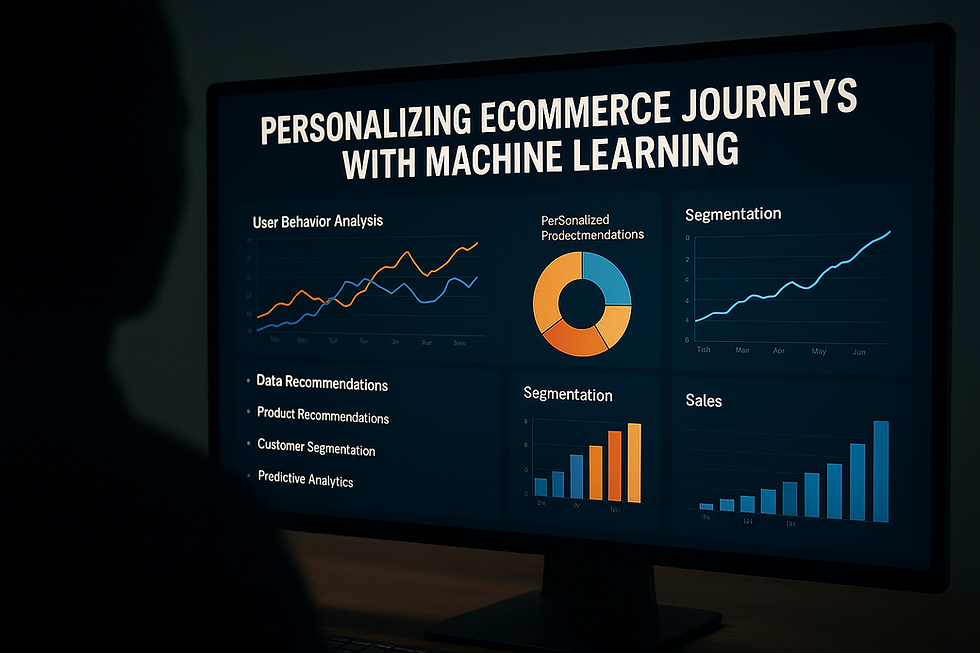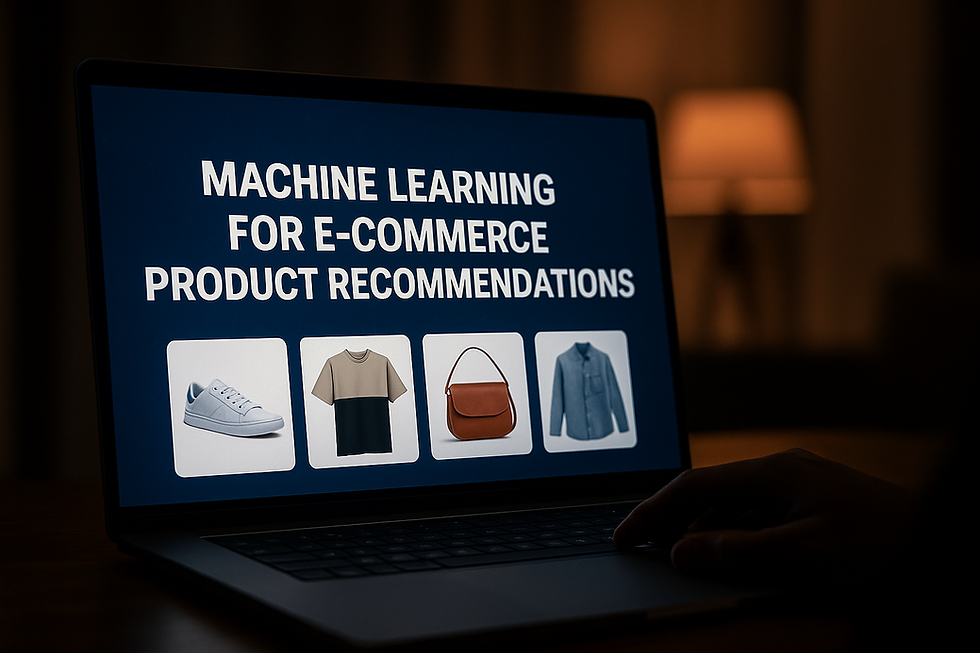Using AI to Reduce Cart Abandonment Rates
- Muiz As-Siddeeqi

- Aug 19
- 5 min read

Using AI to Reduce Cart Abandonment Rates
When Carts Are Full, But Revenue is Empty: The Hidden Crisis in Ecommerce
You did everything right. Beautiful homepage. Fast-loading site. Perfect product pages. Seamless navigation. The customer clicked “Add to Cart.” But then… silence. No order. Just another digital cart lying abandoned in your database.
You're not alone.
According to the Baymard Institute, the average documented online shopping cart abandonment rate is a staggering 69.99% across industries [source: Baymard, 2024]. That means nearly 7 out of 10 customers who show purchase intent—leave. And they don’t come back.
That’s not just disappointing. That’s bleeding revenue.
But here’s the thing: this isn’t a UX problem anymore. This isn’t just about checkout page design or payment gateway friction. No, this has become a data problem—and the solution isn’t redesign. It’s AI.
More specifically, it’s about using AI to Reduce Cart Abandonment Rates with precision, with personalization, and with real-time intelligence.
And in this blog, we’re going to show you—factually, emotionally, and case by case—how businesses are turning cart heartbreaks into confirmed sales using real AI. Not buzzwords. Not hype. Just proven, documented transformations.
Bonus: Machine Learning in Sales: The Ultimate Guide to Transforming Revenue with Real-Time Intelligence
Why Carts Get Abandoned: The Real, Data-Backed Reasons
Before we dive into solutions, let’s clear the fog. Why do customers abandon carts?
Baymard’s 2024 survey of over 5,000 global online shoppers gives us a painfully clear picture [source: Baymard Institute, 2024 Cart Abandonment Report]:
48% said extra costs (shipping, taxes) were too high.
24% said the site asked them to create an account before checkout.
22% experienced slow delivery estimates.
18% didn’t trust the site with their credit card information.
17% said the checkout process was too long or complicated.
Notice something? These aren’t random. These are patterns. And patterns are exactly what AI is made for.
From Guesswork to Precision: Why AI is the Missing Puzzle Piece
Traditional ecommerce platforms operate reactively.
They build a funnel.
They test some variations.
They guess what works.
AI doesn’t guess. It learns. It observes tens of thousands of user journeys, notices behaviors you can’t, and adjusts in real-time.
We’re not talking about vague “recommendation engines” either. We’re talking about machine learning models that:
Detect when a user is about to abandon a cart (in real-time).
Predict the likeliest reason based on behavioral signals.
Trigger the most effective intervention (personalized offer, chatbot nudge, delivery upgrade, etc.).
Learn from the result to optimize future responses automatically.
Real Case Study #1: ASOS Cuts Cart Abandonment with AI-Powered Personalization
British online fashion giant ASOS faced abandonment rates as high as 75% during high-traffic periods. In 2023, they partnered with Microsoft Azure and Adobe Experience Cloud to deploy AI personalization.
According to the public case study from Adobe, ASOS used machine learning to analyze:
Browsing behavior
Return history
Purchase frequency
Price sensitivity
They then used Adobe Sensei to deliver hyper-personalized discounts, dynamic delivery messages, and custom urgency banners based on real-time user data.
Result?
18% reduction in cart abandonment
23% increase in checkout conversions within 90 days
28% higher average order value from returning AI-personalized customers
[source: Adobe + ASOS Case Study, 2023]
Micro-Moments That Matter: Where AI Intervenes
You don’t need to wait for a user to leave the cart page. AI doesn’t. It watches every flicker of hesitation. Here’s where modern ML systems strike:
1. Idle Detection
If a user spends 20+ seconds on the cart page without scrolling, ML can predict uncertainty and trigger a subtle reminder or offer a chatbot popup.
2. Exit-Intent Prediction
AI models track mouse trajectory and cursor speed. If someone moves toward the “close tab” button, AI acts instantly—triggering an exit pop-up or limited-time discount offer.
3. Intent Score Modeling
Platforms like Bluecore use AI to assign every visitor an “intent score” based on dozens of variables. Those with high intent but no conversion trigger premium outreach—SMS, retargeting ads, personalized emails.
4. Dynamic Delivery Intelligence
Amazon isn’t fast by accident. Their AI constantly adjusts delivery ETA displays based on warehouse load, distance, time of day, and customer preferences to retain buyers in the final moments.
Real Case Study #2: Lenskart Increases Checkout Conversions with AI Nudges
India-based eyewear unicorn Lenskart adopted Salesforce Einstein AI in 2022 to reduce their abandonment numbers, which had reached over 70% on weekends.
They used:
Session tracking models to identify “cart hesitation” behavior
Predictive analytics to determine high-value potential buyers
Real-time WhatsApp reminders with dynamic urgency messages
According to Salesforce’s official case study:
Cart abandonment reduced by 20% in 4 months
Return visitor conversion rates jumped 30%
Average checkout time reduced by 35%
And none of this came from redesign. Just data. Just AI.
[source: Salesforce + Lenskart Case Study, 2023]
Cart Rescue Emails Are Dead… Unless Powered by AI
You’ve seen it. “Hey, you left something in your cart…” emails. But guess what?
75% of traditional cart recovery emails are never even opened.
[source: Omnisend Email Benchmark Report, 2023]
But AI flipped this on its head.
Platforms like Klaviyo, Rejoiner, and Emarsys use ML to tailor:
The perfect send time (based on recipient history)
The optimal subject line (A/B tested in real-time)
Personalized content (based on cart items + behavior)
A benchmark study by Klaviyo in 2023 showed:
AI-personalized cart emails had 45% higher open rates
Click-through rates improved by 59%
Recovery conversion rates doubled compared to standard blasts
This isn’t marketing fluff. These are real results from real companies using real machine learning.
Real Case Study #3: HP (Hewlett-Packard) Reduces Abandonment Using Adobe AI
HP saw that 65% of their cart drop-offs came from mobile users. They wanted a smarter system that could adapt the experience based on device behavior.
With Adobe Experience Manager and Adobe Sensei AI, they:
Used real-time analytics to identify friction points in mobile checkout
Dynamically simplified forms for mobile users
Tailored CTAs based on session type and scroll depth
Results within 6 months?
19% decrease in cart abandonment
12% increase in mobile revenue
35% more completed checkouts per session
[source: Adobe Experience Cloud Success Stories, 2023]
AI Isn’t Just Saving Carts. It’s Saving Revenue
Let’s run some numbers.
Say your ecommerce store does $500,000/month in revenue.
Your abandonment rate is 70%. That means only 30% of potential revenue is being realized.
Recover just 15% of those lost carts with AI automation—and you’re adding $175,000/month in recovered revenue.
That’s $2.1 million per year.
And that’s conservative.
Tools Powering Real AI for Cart Abandonment Today
These aren’t secret tools. They’re public, available, and documented:
Bluecore – Predictive abandonment detection for retail
Rejoiner – AI-powered cart recovery email workflows
Salesforce Einstein – End-to-end ecommerce AI
Adobe Sensei – Real-time personalization and abandonment insights
Dynamic Yield – Adaptive UX personalization for ecommerce
Klaviyo AI – Behavioral-driven email and SMS automation
Optimizely – AI-based checkout flow optimization
Nosto – Machine learning for behavioral popups and retention
What Makes AI So Effective Here?
Because unlike traditional funnels, AI doesn’t follow fixed logic. It constantly learns. Constantly iterates. Constantly optimizes.
It adapts for:
Geography
Time of day
Price sensitivity
Traffic source
Cart size
Purchase history
And dozens more micro-variables
No human can manage that. AI does it in milliseconds.
Final Thought: Your Customers Aren’t Lost. They’re Waiting.
Every abandoned cart isn’t a lost customer. It’s a missed moment. A nudge not sent. A pattern not noticed. A behavior not interpreted in time.
But with AI, those moments become opportunities.
We’re not saying it’s magic. We’re saying it’s math. Trained on data. Proven by results. Documented by the world's biggest brands.
If you’re serious about reclaiming revenue, AI for cart abandonment reduction isn’t optional. It’s the new baseline.
And the best part?
You don’t have to invent it. You just have to implement it.

$50
Product Title
Product Details goes here with the simple product description and more information can be seen by clicking the see more button. Product Details goes here with the simple product description and more information can be seen by clicking the see more button

$50
Product Title
Product Details goes here with the simple product description and more information can be seen by clicking the see more button. Product Details goes here with the simple product description and more information can be seen by clicking the see more button.

$50
Product Title
Product Details goes here with the simple product description and more information can be seen by clicking the see more button. Product Details goes here with the simple product description and more information can be seen by clicking the see more button.






Comments